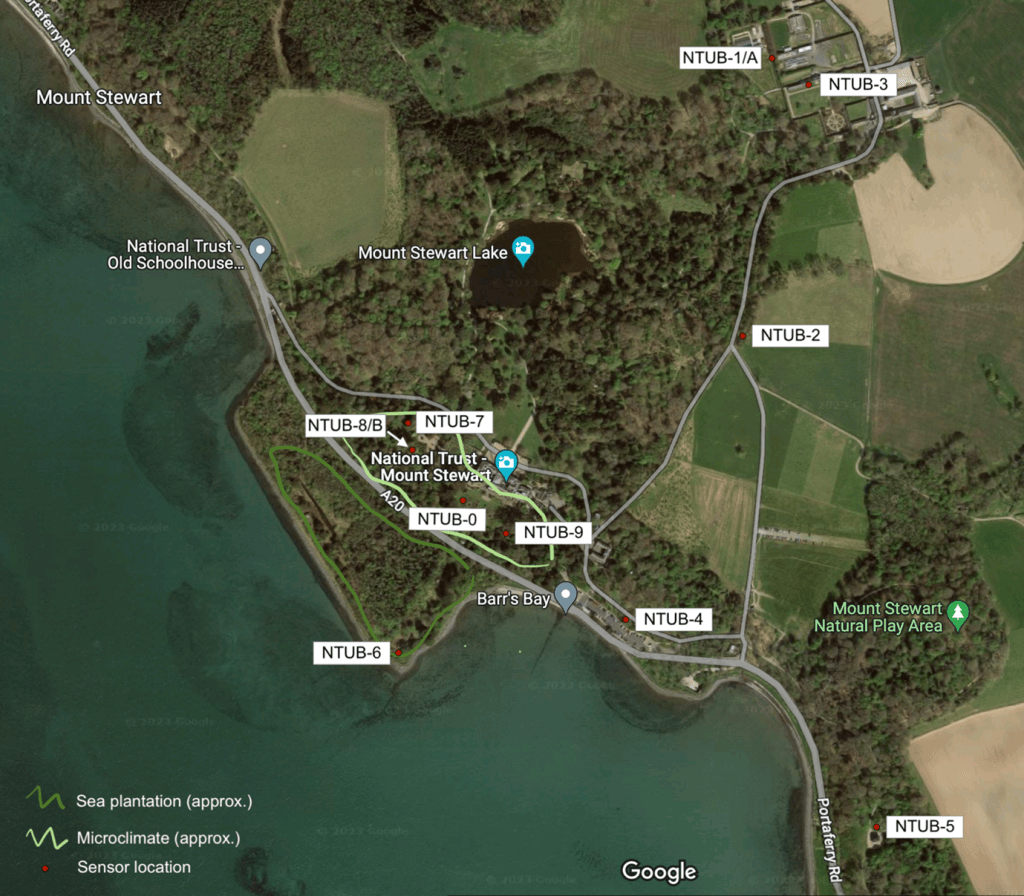Think of Northern Ireland and think of its weather. I wouldn’t blame you if all you knew about Northern Ireland is that it is cool (arguably cold) and wet. A famous pub in Belfast has a sign outside stating “Belfast has seven types of rain: Monday, Tuesday, Wednesday…” The temperature typically doesn’t get above 25 °C. While England’s all-time record temperature is 40.3 °C, Northern Ireland’s is a relatively low 31.3 °C – quite a difference. It doesn’t seem like the sort of place you would attempt to grow banana plants outside all year around. However, in the National Trust’s Mount Stewart gardens, on the shore of Strangford Lough in County Down, that is exactly what you’ll find.
Climate and climate change occurs at all different scales. We all know that the climate we experience as a resident of, for example, Belfast varies from that of Northern Ireland, or the UK in general, or Europe, or the globe. At the same time, even within a relatively small area like Northern Ireland, there will be a large range of unique microclimates as a result of highly localised physical features.
Mount Stewart is one such example of a unique microclimate. Being close to sea level keeps frost and cold extremes at bay, while it has a dense 8-acre sea plantation – a shelter belt of established woodland on the shoreward side of the gardens – that shelters tender plants from the worst of colder sea winds and salt spray. Cocooned behind the shelter belt, Mount Stewart’s range of gardens grow a huge variety of plants, including bananas, and have been voted one of the best gardens in the world.
Gardeners working at Mount Stewart have known its microclimate is unique for years, however in the face of climate change, the National Trust are taking action to get ahead of the curve and plan for the future. In recent years, high storm surges have caused salt water intrusion in parts of the ornamental gardens, with the salinity subsequently damaging or killing many plants that required replanting. Long-term, such flooding seems inevitable and is even expected to take the sea plantation with it.
To understand exactly the nature of the microclimate of Mount Stewart and the importance of its sea plantation, University of Bristol have teamed with the National Trust to install 12 sensors around the site to measure the temperature, humidity, soil temperature, soil moisture and precipitation. These sensors cover the ornamental gardens’ microclimate (some sensors are literally amongst the banana plants), the walled gardens and in the land surrounding the microclimate, on the edge of agricultural areas and on the shoreward side of the sea plantation.

The project began monitoring in July 2023. We hoped to capture how the microclimate responded through summer heatwaves, but instead had the rainiest July on record in Northern Ireland. Not to worry – that’s interesting data to capture too. The project plans to run for as long as we can maintain the sensors at the site, capturing heatwaves, cold snaps, storms and everything in between over the coming years. The variation in climate across Mount Stewart will be quantified, including the effect of the much-hyped sea plantation. At the same time, the offset between the weather recorded by Met Office or reanalysis data products for Northern Ireland in general versus at the Mount Stewart site will be calculated, allowing local scale bias corrections to be applied to historic records and potentially future climate model projections.
The initial results collected so far provide some tantalising and surprising insights. At least for a cool, wet summer like Northern Ireland has just experienced, the microclimate is in fact not warmer than the surrounding countryside. The warmest part of the site – perhaps unsurprisingly – was found to be the walled garden. However, that still leaves me wondering how the bananas survive in ‘normal’ Northern Irish weather! The true test of the microclimate and sea plantation’s effect may be seen during the coming winter, where this area is expected to be milder and significantly less frost prone.
The information from this project will be used by the National Trust to plan their next steps. They are already in the process of planting the next generation of sea plantation further inland and ultimately the majority of the gardens may have to move. Understanding how the microclimate varies will help inform where is best to resituate the existing planting and gardens. This project is a trial and if it is useful and successful, the National Trust may carry out similar analysis at other sites across the UK. As a climate researcher, I love data! However, a research question which we hope to answer with this project is whether more data is always necessary? The gardening team at Mount Stewart have a very detailed knowledge of the microclimate in terms of what plants thrive where and when – just not in terms of graphs and numbers. We will explore whether quantifying this microclimate provides added value above and beyond tacit local knowledge.
Gardeners always keep one eye on the future. Seeds are sown expecting shoots in the spring. Saplings are planted expecting an orchard in decades to come. This project will help the National Trust’s gardening team to make decisions that will shape this garden into the next century and maybe beyond. This ‘seedcorn funding’ has taken on a different and very literal meaning.
This work was funded by University of Bristol’s Third Sector Impact Seedcorn funding. The project team includes Alan Kennedy-Asser and Simon Cobb (School of Geographical Sciences) and Keith Jones (National Trust). Thanks to the gardening team at Mount Stewart including Mike Buffin, Robert Wilson and Abigail Wilson for their support in running and maintaining the sensors. You can hear Mike Buffin discussing the project on BBC Radio Ulster’s Gardeners’ Corner programme here.
———————————
This blog is written by Cabot Institute for the Environment member Dr Alan Kennedy-Asser, University of Bristol.


Thank you for the comment and taking the time to read the article Peter. Apologies for confusion caused – I have spoken to the National Trust about this and we have agreed the word ‘inundated’ might have been misleading, however they are confident that damage in the Spanish Garden was caused by salt water intrusion beneath the walls during a storm surge. I have updated the article accordingly.
Hi,
really enjoyed your article. If i were trying to find out information on local microclimate conditions (near BT473DD, northern ireland, approx.) is there a source or service that comes to mind for you?
I’m planning on building a passive house there and finding environmental ranges/ things to consider for the building envelope are hard to pin down (light, temperature ranges, rainfall etc).
many thanks!!
Hi Tony,
Many thanks for taking the time to read the article and glad you enjoyed it. Your building plan sounds exciting! I don’t know if any online datasets that are exactly tailored to what you are looking for. From a temperature perspective there is an online app you could check out that I produced for Climate NI. The ‘Local Changes’ section of https://ukcrp.shinyapps.io/RuralHeatNI/ allows you to enter the postcode of your site and will show you the number of days per year expected to exceed 25 and 22 °C and nights per year that would exceed 15 °C. This is taking data from the UK Met Office projections.
For rainfall, you might be able to get some information from another interactive app I would recommend: https://uk-cri.org/. In that app, if you select 12x12km for ‘Spatial resolution’ you can then zoom in and click on the box closest to Greysteel. It has many different weather variables, but sadly no information on light. This also uses data from the UK Met Office projections.
I hope you might find this of some use.
Thanks,
Alan